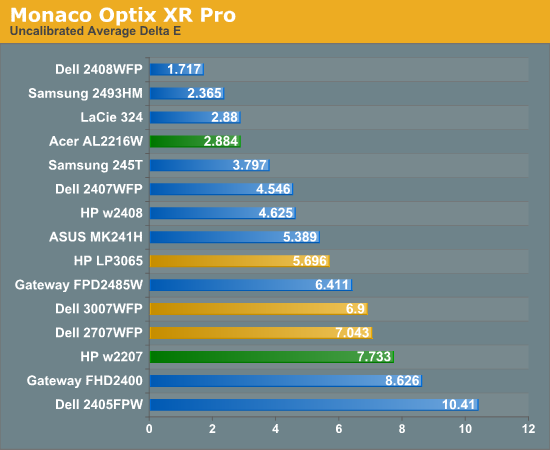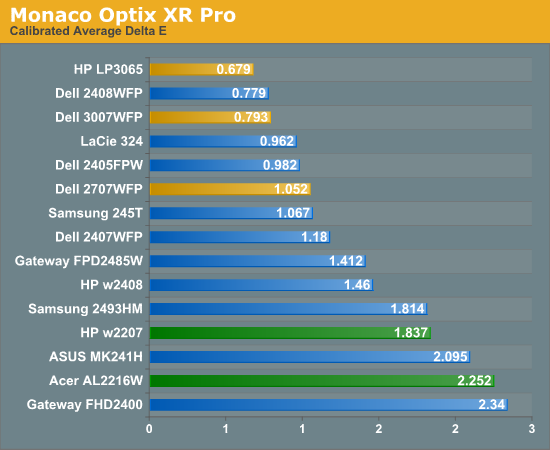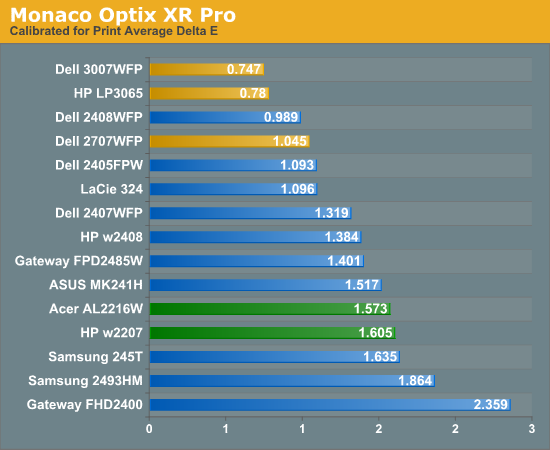Color Accuracy
Imaging professionals definitely like to have accurate colors, and the best way of assuring that your display shows the proper colors is to use a colorimeter and calibration software. However, not everyone has access to such tools and many users are unwilling to spend over $200, so we test before and after calibration. (Put more accurately, we calibrate the monitors and then tweak the created profile back to an uncalibrated state so that we can evaluate the performance of the display in its default state.) For calibration, we target a white level of 250 nits -- anything more than that is too bright in our opinion. We also do a second calibration targeting a white level of 100 nits, which would be useful when working on material that will end up in print form. Before we get the results, here are the display settings we used on the test LCDs. We let the LCDs stabilized for at least one hour before performing measurements.
| LCD Brightness and Contrast Settings | ||
| Standard Calibrated (~250 nits) | Calibrated for Print (~100 nits) | |
| ASUS MK241H | 45 Brightness, 80 Contrast 100-100-100 RGB |
50 Brightness, 80 Contrast 54-51-73 RGB |
| Dell 2408WFP | 50 Brightness, 50 Contrast 80-80-80 RGB |
48 Brightness, 50 Contrast 55-55-55 RGB |
| Gateway FHD2400 | 70 Brightness, 70 Contrast 76-77-92 RGB |
50 Brightness, 50 Contrast 57-57-70 RGB |
| LaCie 324 | 35 Brightness, 0 Contrast 128-128-128 RGB 2.2 Gamma, 6500K |
7 Brightness, 0 Contrast 128-128-128 RGB 2.2 Gamma, 6500K |
| Samsung 2493HM | 60 Brightness, 75 Contrast 100-100-100 RGB |
28 Brightness, 75 Contrast 46-37-65 RGB |



Starting with the uncalibrated results, it's pretty easy to see why we feel calibration tools are necessary for most users. This is not to say that you can't be happy with inaccurate colors -- your eyes will compensate, and some people prefer warmer (redder) or cooler (bluer) tones. However, if you're doing work with images or video as an example, it is important that what you see on your display matches as much as possible what others will see on their displays. Of the tested LCDs, only four are able to achieve an average Delta E of less than 3.0 without calibration -- three of which happen are part of this roundup. That's encouraging, as it indicates LCD manufacturers may be spending a bit of extra time to ensure that at least one of the settings will provide neutral, accurate colors. The real shocker however is the Dell 2408WFP. Its uncalibrated Delta E reaches an exceptional 1.7 -- a score that's better than several of the LCDs after calibration!
With calibration, all the scores improve substantially, but anyone serious about color accuracy is probably going to want an average Delta E of around 1.0 or less after calibration. Of the tested monitors, the 24" Dell displays (all three models that we've tested), the LaCie 324, and the two 30" LCDs all manage to accomplish this, along with the Dell 2707WFP and Samsung 245T. Switching to appropriate "printing" settings puts the three largest LCDs at the top of the charts, along with the Dell 2408WFP (and the old 2405FPW) and LaCie 324.
Most of the LCDs in this roundup place in the middle or upper portion of the above graphs, with one exception. The Gateway FHD2400 comes in last or in second to last in all three tests. We actually really like the Gateway display for many of its features, but in terms of color accuracy it is definitely lacking. We spent a substantial amount of time trying to tweak the settings in order to achieve better results, all to no avail. There's more to LCDs than color accuracy, of course, and the price and appearance might be enough to help you overlook the relatively poor performance here.










89 Comments
View All Comments
feraltoad - Friday, May 2, 2008 - link
Do you think a subsequent Dell Revision will fix this or as you suggest are we seeing possible limitations in that panel technology?Currently some users are reporting a "red tint" on the left side of their monitors. Has anyone experienced this?
Owners of the Dell 2408 I would appreciate some opinions about this monitor, because I want to upgrade to a 24inch LCD (& get rid of a CRT on a second PC), but as I currently have a 21inch LCD (HP f2105) that I am mostly happy with I want to get something thing that will be a definite improvement. As Jarred states the Dell, sans any lemons, looks to be perfect except for the slight input lag, and that's the concensus I've seen among opinions on various sites. I don't think I could even notice but I would like to hear some people with experience with the 2408. I would value Anandtech readers' opinions more than reviews off Dell's site since we are probably more on the same page.
Gast - Friday, May 2, 2008 - link
http://forums.anandtech.com/messageview.aspx?catid...">http://forums.anandtech.com/messageview.aspx?catid...From this should come your dork binding monitor, which looks to be the DoubleSight DS-263N with the chance of a polarizer. I'm sad that the article neglected to even mention this great resource.
rcraig - Friday, May 2, 2008 - link
I, too, am waiting for a review of the DoubleSight DS-263N. I have read a lot about this monitor in another forum and it seems to be the one monitor to rule them all. Great colors for phtotgraphs, low lag for games, IPS for great viewing angles, and 26 inches for only $680! It only lacks the many input features some offer, but it does offer dual DVI, VGA, and 4 USB's.JarredWalton - Friday, May 2, 2008 - link
I've sent a couple email messages to DoubleSight, so far with no response. Same goes for a variety of other manufacturers. I'd love to go out and buy the LCDs I want to review, but that's not financially practical. :-(XtAzY - Friday, May 2, 2008 - link
I'm just skimming through the article, but does it mention anything about GHOSTING?JarredWalton - Friday, May 2, 2008 - link
You're talking about pixel response times. See page 12 and look at the images.musicman1352000 - Friday, May 2, 2008 - link
I have been waiting - desperately hoping and praying - that anandtech would review the dell 2408. It seems to be a stand out performer to me but I've been really put off buying it by the number of complaints of pink/red "tint", uneven brightness, colourful font halos, and bad input lag posted in forums. Reviews contradict each other and many people are waiting for a revision to solve the perceived problems like input lag (coming from an engineer, I am fully aware this particular problem can't be solved by a revision!). What I'd like to know is whether you noticed any of the problems I mentioned (not including the input lag which you obviously picked up on), and what revision of monitor you received (A00 or A01)? Also, Dell don't seem keen on telling users what versions of HDMI and displayport are used - do you know anything about this?JarredWalton - Friday, May 2, 2008 - link
I noticed no problems with the quality of the panel on the 2408WFP I received, with is revision A00. However, that doesn't mean some panels don't have problems. If overall quality is that important, LaCie seems to do a better job judging by their reputation (and price).I imagine part of the problem users have is that the default brightness on many monitors is way too high, and sometimes color settings need to be turned down as well. You can see that at 80-80-80 RGB with 50 on brightness and contrast, the Dell achieved exceptional color accuracy even without calibration. Is this just a cherry-picked sample? I certainly hope not!
I have no idea what version of DisplayPort the 2408 uses - and lacking any video cards with the feature I couldn't even test it right now. For HDMI, I would assume it's not 1.3, but I could be wrong. Probably v1.1 or maybe 1.2 - is there any easy way to tell? If someone can point me to a utility that will report the HDMI version, I'll be happy to test.
musicman1352000 - Friday, May 2, 2008 - link
Mmm okay - thank you for replying.One of the worst things about living in New Zealand is the increased cost of buying computer parts, and the reduced ranges available (see http://www.pricespy.co.nz/cat_5.html#g147)">http://www.pricespy.co.nz/cat_5.html#g147). The Dell costs $1199.00 NZD here (and the Lacie is unavailable). That's approximately $930 when translated to USD. As I understand it the cost is ~$700 in the US?
With regards to the HDMI/displayport versions: unfortunately I don't know of any way in which you could test the display to find out. Tektronix offers software for 1.3b compliance testing (trial: http://www2.tek.com/cmswpt/swdetails.lotr?ct=SW&am...">http://www2.tek.com/cmswpt/swdetails.lo...CDSA7160...
but I think this is more engineering oriented. Maybe someone else has a suggestion?
Thanks once again for your opinions :)
feelingshorter - Friday, May 2, 2008 - link
I hope anandtech reviews some of the cheaper monitors in the future also. The cheapest monitors reviewed, being the gateway/samsung at 450 is a steep price for some of us.Just to name the cheaper ones on newegg, SCEPTRE X24WG is at 300 (AR) and seems to be the poor man's 24, or the KDS K-24MDWB at 350 is also at a reasonable price. Plus wouldn't comparing the low end be a good idea to see if you can justify paying for a $1000 lacie (or 500+) gets you more?